
FTTH - GPON
GPON (Gigabit Passive Optical Networks) is an Optical System for the Access Networks, based on ITU-T specifications G.984 series. It can provide a 20 km reach with a 28dB optical budget (shown in the following illustration) by using class B+ optics with 1:32 split ratio.
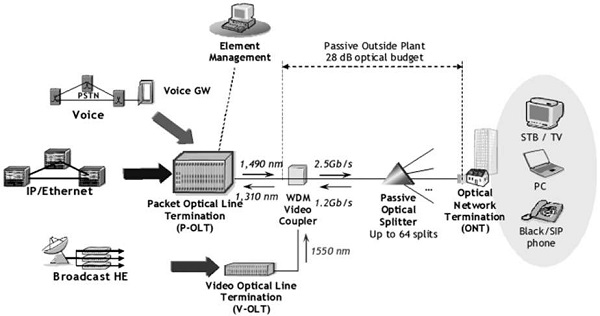
GPON system supports the following rates −
- 155 Mbps upstream, 1.24416 Gbps downstream
- 622 Mbps upstream, 1.24416 Gbps downstream
- 1.24416 Gbps upstream, 1.24416 Gbps downstream
- 155Mbps up, 2.48832 Gbps downstream
- 622 Mbps up, 2.48832 Gbps downstream
- 1.24416 Gbps up, 2.48832 Gbps downstream
- 2.48832 Gbps up, 2.48832 Gbps downstream
GPON supports both ATM and GEM encapsulation. GEM (GPON Encapsulation Method) supports both native TDM and Data.
GPON Features
This evolutionary technology is based on BPON GEM. Following are its features −
Downstream transmission
- 2.4 Gbps
- BW for one ONT is sufficient to supply multiple HDTV signals
- QOS allows for delay sensitive traffic (voice)
Upstream transmission
- 1.24 Gbps
- Minimum BW can be guaranteed
- Unused time-slots can be assigned to heavy users
- QoS allows to delay sensitive traffic (voice)
Why GPON?
GPON provides integrated services solution such as −
It supports Triple Play ser vices.
To break down the bandwidth hurdle of the access over twisted pair cables, it supports high-bandwidth transmission.
It reduces the network nodes.
It supports up to 20 km service coverage.
GPON Standards
GPON standards are built on the previous BPON specifications. The specifications are −
G.984.1 − This document describes the Gigabit-Capable Passive Optical Network general characteristics.
G.984.2 − This document describes the Gigabit-Capable Passive Optical Network Physical media-Dependent layer specification.
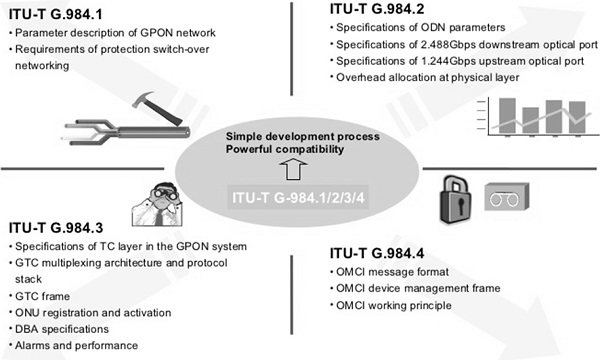
- G.984.3 − This document describes the Gigabit-Capable Passive Optical Network Transmission Convergence Layer Specification.
- G.984.4 − This document describes the Gigabit-Capable Passive Optical Network ONT Management and Control Interface Specification (OMCI).
GPON Architecture
GPON OLT serves multiple ONTs through the PON port. The downstream transmission, i.e., from OLT to ONT is usually TDM; whereas the upstream traffic, i.e., from ONT to OLT is usually TDMA.
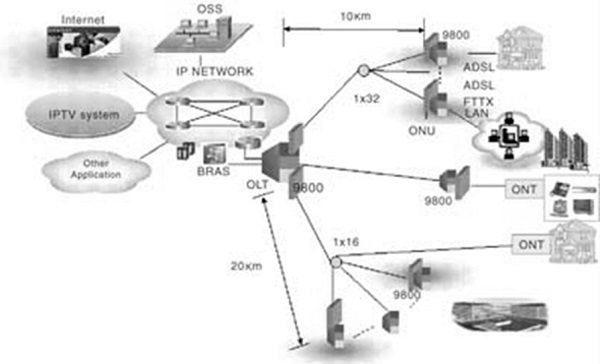
PON system may be symmetrical or asymmetrical. PON and fiber infrastructure can also be used for supporting any one-way distributive service. For example Video at a different wavelength.
GPON Physical-Media Dependent Layer
G.984.2 is the specification of the physical layer of the GPON system. The physical layer addresses areas such as −
- Optical performance in terms of data rate.
- The class of optical fiber components.
- The timing and control of the optical power.
- Forward error correction.
One of the basic requirements of an optical system is to provide components with sufficient capacity to extend the optical signal to the expected range. There are three categories or classes of components, which are based on power and sensitivity. The classes of components are −
- Class A optics: 5 to 20dB
- Class B optics: 10 to 25dB
- Class C optics: 15 to 30dB
Optical Line Terminal (OLT)
The OLT provides the service node interface (SNI) (typically 1 Gbps and/or 10 Gbps Ethernet LAN interfaces) towards the core network, and controls the GPON. The OLT consists of three major parts −
- Service port interface function
- Cross-connect function
- Optical distribution network (ODN) interface
The following illustration shows the typical OLT functional block diagram.
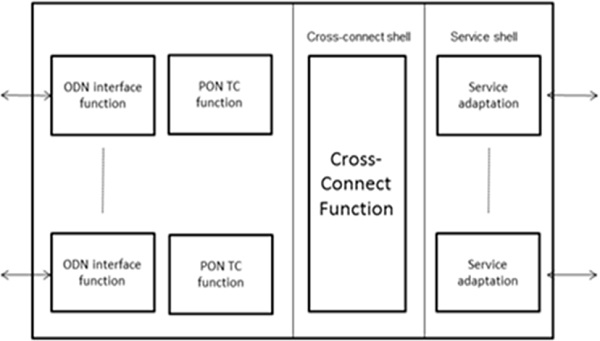
PON Core Shell
PON Core shell consists of two parts. The first part is ODN interface function and the part is PON TC function. PON TC function includes OAM, media access control, framing, DBA, delineation of protocol data unit (PDU) for the cross-connect function, and for the ONU management.
Cross-connect shell − This shell provides a communication path between the PON core shell and the service shell.
Service shell − This shell is for translation between service interfaces and the TC frame interface of the PON section.
ONU/ONT
The Optical Network Unit (ONU) operates with a single PON interface or maximum two interfaces for link protection purposes. In case, any one fiber out of these two fibers is cut the ONU can be accessed through other fiber. This is called PON protection or Link Protection. Link protection is also known as link aggregation, which can protect the link and the same time, it can aggregate the traffic as well.
The service MUX and DEMUX function connects the Customer devices to PON side. The Optical Network Terminal (ONT) is designed for single subscriber use, while the ONU (Optical Networking Unit) is designed for multiple subscriber use. The splitters allow the PON to be shared by up to 128 ONTs or ONUs.
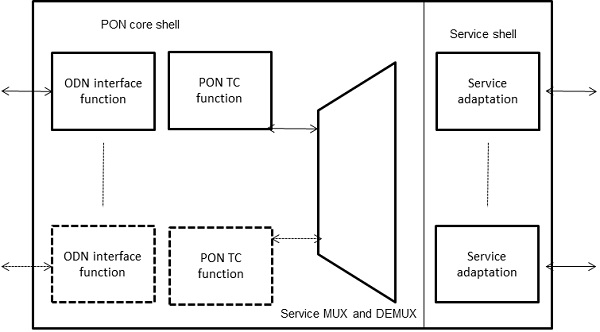
ONT/ONU Interfaces
The optical network terminal (ONT), which is connected to the OLT at uplink side for service network interface, has many user-network interface ports. Typically, there will be four FE/GE ports towards UNI.
UNI Ports for Residential ONT − Typically, the subscriber service interfaces such as 10/100Base-T High Speed Internet (HSI) and video over IP, RF coaxial for RF video overlay systems, and FXS telephone interfaces analog for VoIP PSTN voice.
UNI ports for a business ONT − In addition to the above, may also include 10/100/100Base-T routers and L2 / L3 switches interfaces and DS1/E1 PBX for key systems.
The optical network unit (ONU) terminates the GPON fiber and has much more user network interface (UNI) to multiple subscribers. UNI interface can be ADSL2+, VDSL2, Power Line, MoCA or HPNA, and the distance to the subscriber (10/100 Base-T is limited to 100m, which is 330 ft.).
According to the type of interface ports, UN UNI may not be able to connect directly to a subscriber CPE equipment. In this case, the UN UNI connects to a network termination (NT), which is placed at the final location of the subscriber. NT terminates the CPE equipment of the subscriber, such as a PC, Wireless Router, Telephone, IP Video Set-Top Box, or Set-Top Box, RF Video, etc.
Essentially, an ONT combines the function of an ONU and an NT in a single device. This combination of the two; together makes the ONT the most cost effective solution to provide GPON services to local and single-family, small, and medium enterprises. However, if a client on campus as students, hostels, schools, colleges, hospitals, or corporate offices, where there is already CAT-5 copper cable is laid, ONU can serve as a more appropriate solution.
Optical Distribution Network
The GPON ODN, consisting of a single mode optical fiber and cable; the optical fiber ribbon cables, splices, optical connectors, passive optical splitters and passive branching components are very passive.
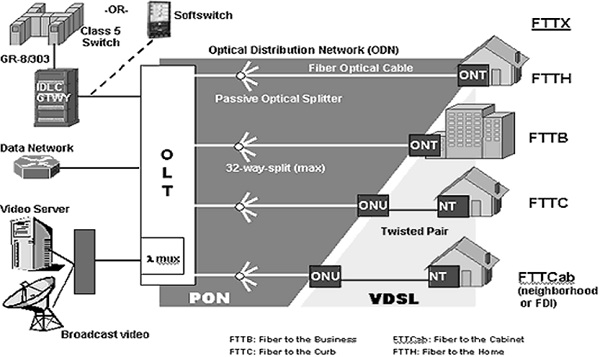
The ODN optical splitters divide the single fiber into multiple fibers going to different buildings and individual homes. The splitters can be placed in any location in the ODN, from the Central Office (CO)/ Local Exchange (LE) to the customer premises and may be of any size. The splitters are designated as [n:m], where n is the number of input (towards OLT) = 1 or 2, and m is the number of outputs (towards ONT) = 2,4,8,16,32,64.
GPON Multiplexing/ Framing
The GPON multiplexing or framing is explained with the following factors.
GPON Encapsulation Method (GEM)
It is the data transport scheme in the specified GPON transmission convergence layer. GEM provides a connection-oriented, variable-length framing mechanism for transport of data services over the passive optical network (PON). GEM is designed to be independent of the type of the service node interface at the OLT as well as the types of UNI interfaces at the ONUs.
Downstream Traffic (OLT towards ONU/ONT)
For downstream traffic, the traffic multiplexing functions are centralized in OLT. A GEM Port-ID, in the form of a 12-bit number assigned by the OLT to the individual logical connections, identifies the GEM frames that belong to different downstream logical connections. Each ONU filters the downstream GEM frames based on their GEM Port-IDs and processes only the GEM frames that belong to the ONU.
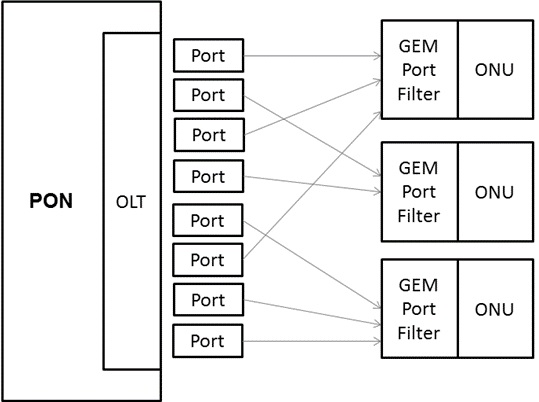
Upstream Traffic (ONU/ONT towards OLT)
The traffic bearing entities within the ONU are granted upstream transmission opportunity (or bandwidth allocation) by the OLT. These traffic-bearing entities are identified by the allocation IDs (Alloc-IDs). The allocation identifier (Alloc-ID) is a 12-bit number that the OLT assigns to an ONU to identify a traffic-bearing entity. It is a recipient of upstream bandwidth allocations within the ONU.
The bandwidth allocations to different Alloc-IDs are multiplexed in time as specified by the OLT in the bandwidth maps transmitted downstream. Within each bandwidth allocation, the ONU uses the GEM Port-ID as a multiplexing key to identify the GEM frames that belong to different upstream logical connections.
A Transmission container (T-CONT) is an ONU object representing a group of logical connections. It appears as a single entity for the purpose of upstream bandwidth assignment on the PON. Based on the mapping scheme, service traffic is carried to different GEM ports and then to different T-CONTs.
The mapping between the GEM port and the T-CONT is flexible. A GEM Port can correspond to a T-CONT; or multiple GEM Ports can correspond to the same T-CONT.
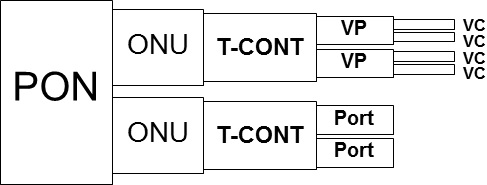
G-PON Transmission Convergence Layer (GTC)
A protocol layer of the G-PON protocol suite that is positioned between the physical media dependent (PMD) layer and the G-PON clients. The GTC layer is composed of GTC framing sub-layer and GTC adaptation sub-layer.
In the downstream direction, the GEM frames are carried in the GTC payload, which arrive at all the ONUs. The ONU framing sub-layer extracts the frames, and the GEM TC adapter filters the frames based on their 12-bit Port-ID. Only frames with the appropriate Port-IDs are allowed through to the GEM client function.
In the upstream direction, the GEM traffic is carried over one or more T-CONTs. The OLT receives the transmission associated with the T-CONT and the frames are forwarded to the GEM TC adapter and then the GEM client.
GTC Layer Framing
The downstream frame has a duration of 125 microseconds and is 38880 bytes long, which corresponds to the downstream data rate of 2.48832 Gbit/s. The downstream GTC frame consists of the physical control block downstream (PCBd) and the GTC payload section.
GPON Transmission Convergence frames are always 125 Msec long −
- 19440 bytes/frame for 1244.16 rate
- 38880 bytes/frame for 2488.32 rate
Each GTC frame consists of Physical Control Block downstream + payload
- PCBd contains sync, OAM, DBA info, etc.
Payload may have ATM and GEM partitions (either one or both)

The upstream GTC frame duration is 125 s. In G-PON systems with the 1.24416 Gbit/s uplink, the upstream GTC frame size is 19,440 bytes. Each upstream frame contains a number of transmission bursts coming from one or more ONUs.
Each upstream transmission burst contains an upstream physical layer overhead (PLOu) section and one or more bandwidth allocation intervals associated with the individual Alloc-IDs. The downstream GTC frame provides the common time reference for the PON and the common control signaling for the upstream.
GPON Payloads
GTC payload potentially has two sections −
- ATM partition (Alen * 53 bytes in length)
- GEM partition (now preferred method)

ATM Partition
The ATM partition has the following characteristics.
- Alen (12 bits) is specified in the PCBd.
- Alen specifies the number of 53B cells in the ATM partition.
- If Alen = 0 then no ATM partition.
- If Alen = payload length/53, then no GEM partition.
- ATM cells are aligned to GTC frame.
- ONUs accept ATM cells based on VPI in ATM header.
GEM Partition
The GEM partition has the following characteristics.
- Unlike ATM cells, GEM delineated frames may have any length.
- Any number of GEM frames may be contained in the GEM partition.
- ONUs accept GEM frames based on 12b Port-ID in GEM header.
GPON Encapsulation Mode
A common complaint against BPON was inefficiency due to the ATM cell tax. GEM is similar to ATM. It has constant-size HEC-protected header. However, it avoids large overhead by allowing variable length frames. GEM is generic any packet type (and even TDM) supported. GEM supports fragmentation and reassembly.
GEM is based on GFP, and the header contains the following fields −
- Payload Length Indicator - payload length in Bytes.
- Port ID - identifies the target ONU.
- Payload Type Indicator (GEM OAM, congestion/fragmentation indication).
- Header Error Correction field (BCH(39,12,2) code+ 1b even parity)
The GEM header is XOR'ed with B6AB31E055 before transmission.

Ethernet/TDM over GEM
When transporting Ethernet traffic over GEM
- Only MAC frame is encapsulated (no preamble, SFD, EFD)
- MAC frame may be fragmented (see next slide).
Ethernet over GEM
When transporting TDM traffic over GEM −
- TDM input buffer polled every 125 Msec.
- PLI bytes of TDM are inserted into payload field.
- Length of TDM fragment may vary by ± 1 Byte due to frequency offset.
- Round-trip latency bounded by 3 msec.

TDM over GEM

GEM can fragment its payload. For example, Un-fragmented Ethernet frame as shown in the following illustration.

The following illustration depicts a Fragmented Ethernet frame.

GEM fragments payloads for either of the following two reasons −
Reason 1 − GEM frame may not straddle GTC frame.

Reason 2 − GEM frame may be pre-empted for delay-sensitive data.

GPON Encryption
OLT encrypts using AES-128 in the counter mode. Only payload is encrypted (not ATM or GEM headers). Encryption blocks are aligned to the GTC frame. Counter is shared by OLT and all ONUs as follows −
- 46b = 16b intra-frame + 30 bits inter-frame.
- Intra-frame counter increments every 4 data bytes.
- Reset to zero at beginning of DS GTC frame.
OLT and each ONU must agree on a unique symmetric key. OLT asks ONU for a password (in PLOAMd). ONU sends password US in the clear (in PLOAMu) −
- Key sent 3 times for robustness
OLT informs ONU of precise time to start using new key.
QoS GPON
GPON treats QoS explicitly. Constant length frames facilitate QoS for time-sensitive applications. There are 5 types of Transmission Containers −
- Type 1 − fixed BW.
- Type 2 − assured BW.
- Type 3 − allocated BW + non-assured BW.
- Type 4 − best effort.
- Type 5 − superset of all of the above.
GEM adds several PON-layer QoS features −
- Fragmentation enables pre-emption of large low-priority frames.
- PLI - explicit packet length can be used by queuing algorithms.
- PTI bits carry congestion indications.
In the next chapter, we will understand what Ethernet Passive Optical Network is.